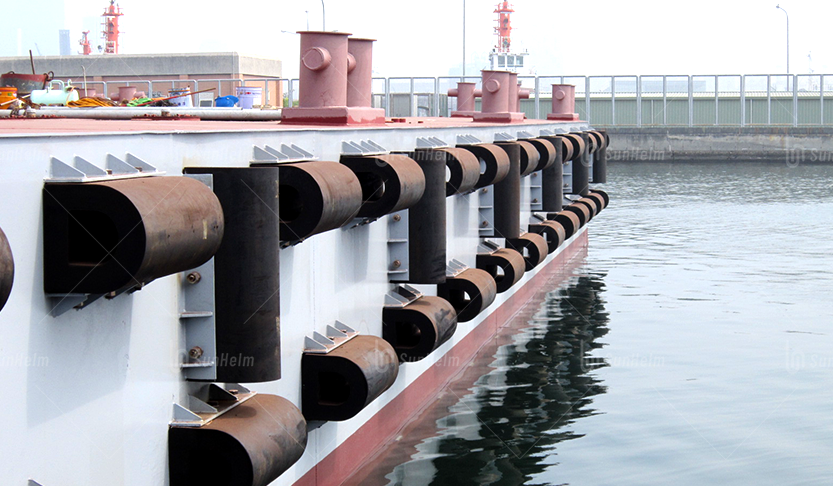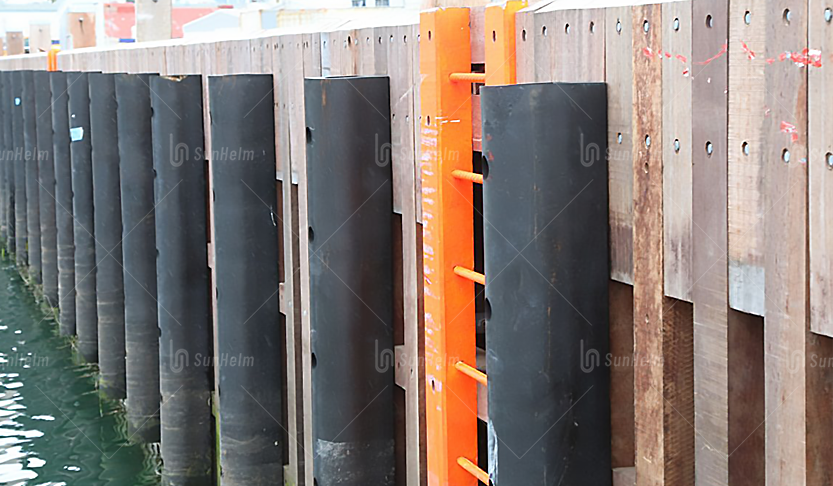D fenders play an important role in protecting ships and marine structures during berthing. They absorb impact energy and reduce the force transferred to both the vessel and the dock. Because of their simple shape and cost-effective design, many ports, marinas, and shipyards use them as a reliable solution. In this article, you will learn about their main purposes, types, applications, installation, and advantages.

Primary Purposes of D Fenders
The main role of D fenders is to provide reliable and efficient protection during berthing operations. Their purposes include:
- Energy absorption – When a ship comes into contact with a dock or quay wall, D fenders compress and absorb impact energy. As a result, they prevent damage to both sides.
- Reduced reaction force – By spreading the load, D fenders lower the stress on ship hulls and docking structures.
- Structural protection – They act as a buffer and stop cracks, dents, or paint damage.
- Guidance during berthing – Since they can run continuously along walls or posts, they guide ships smoothly into position.
- General cushioning – In addition to marine use, D fenders also serve as bumper strips in warehouses, trucks, and loading areas.
How D Fenders Work
When compressed, the rubber material of a D fender deforms and then recovers, similar to a spring. This process absorbs energy from the moving vessel and limits the rebound force. Engineers usually describe performance with two values:
- Energy absorption capacity – the amount of energy the fender can take in without failing.
- Reaction force – the force that pushes back on the ship and the dock.
Because D fenders balance these two factors, they suit smaller and medium-size vessels where moderate impact protection is enough.
Types of D Fenders
You can find several types of D fenders designed for different conditions:
- Solid rubber D fenders – The most common type, durable and easy to install.
- Hollow D fenders – More flexible and able to absorb higher energy thanks to the hollow core.
- Foam-filled D fenders – Lightweight and floating, useful where buoyancy matters.
- Reinforced with steel or nylon inserts – Stronger designs for heavy-duty use.
Typical Applications
Because of their adaptability, D fenders work in many places:
- Small and medium-sized ports
- Ferry and fishing boat terminals
- Inland waterways and locks
- Barge berthing areas
- Yacht marinas
- Ship repair yards and dry docks
In addition, industries outside the marine sector also use them for impact protection in loading bays and vehicles.
How to Choose the Right D Fender
Selecting the correct D fender requires careful consideration of operating conditions. Important factors include:
- Vessel size and displacement – Larger vessels create higher impact energy.
- Approach speed – Higher berthing speeds demand stronger fenders.
- Required performance – You need to balance energy absorption with low reaction force.
- Installation space – Limited wall or dock area may restrict fender size.
- Environmental conditions – UV, saltwater, and temperature directly affect material life.
- Budget and maintenance plan – You must decide between standard solid rubber or more advanced reinforced types.
Therefore, a good selection process starts with calculating expected berthing energy, then comparing fender models, and finally verifying installation requirements.
Mounting & Installation Best Practices
You should always mount D fenders correctly to ensure performance. Common methods include:
- Through-bolting – Bolts pass through the fender and connect firmly to a backing structure.
- Bolted-on with steel plates – A plate spreads loads and keeps the fender stable.
- Welded brackets – Shipyards and heavy-duty docks often rely on this method.
In addition, installers must keep proper spacing between bolts to avoid uneven stress. They should protect all metal parts against corrosion and check alignment and drainage. By following these steps, you can prevent premature wear and extend fender life.
Advantages vs Limitations
Advantages:
- Cost-effective solution
- Simple and flexible installation
- Suitable for narrow spaces
- Reliable performance for small and medium vessels
Limitations:
- Lower energy capacity compared with cone or panel fenders
- Not ideal for very large vessels or high-energy berthing operations
FAQs about D Fenders
1. What is the difference between D fenders and U fenders?
D fenders have a flat back and a “D” shape, while U fenders are deeper and absorb more energy.
2. Can D fenders be used for large cargo ships?
They mainly suit small to medium vessels. Large ships usually need cone, cell, or pneumatic fenders.
3. How long do D fenders last?
With quality materials and correct installation, they often serve for many years under normal conditions.
4. Do D fenders require a backing plate?
Yes, in most cases. A backing plate spreads loads and increases durability.
5. Can they be used in both fresh and salt water?
Yes, provided the rubber compound is designed for marine environments.
Conclusion
D fenders provide vital protection for ships and port structures. They absorb berthing energy, reduce reaction forces, and guide vessels safely into position. Moreover, their versatility and cost-effectiveness make them a popular choice for marine and industrial applications. By selecting the right type and installing them properly, operators can achieve long-lasting safety and performance.


